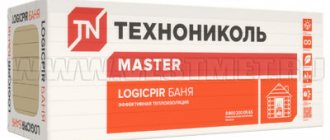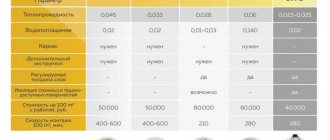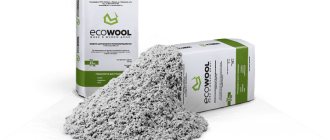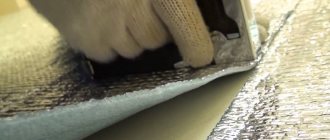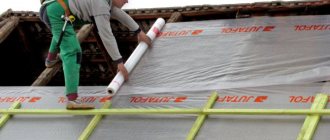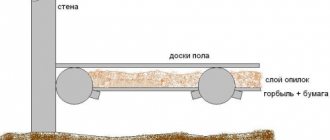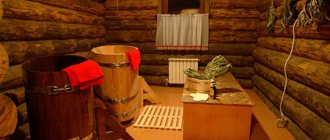Properties and scope
It should be noted that in general, insulation materials based on polyurethane foam are somewhat inferior to their classic counterparts in terms of affordability. For this reason, these thermal insulation materials have not yet become as widespread as insulating building materials made from mineral wool, expanded polystyrene and polystyrene, the production of which is based on the extrusion method.
The issue of availability of polyurethane insulation materials for purchase is explained by the fact that the thermal insulation of a house requires a fairly large consumption of foam insulation. Until recently, this problem was solved by involving various contractors or by attempting to solve it independently through the acquisition of raw materials and special equipment, as well as the need to personally master thermal insulation technology.
The appearance of Polynor insulation on the market radically changed the situation. Now, to insulate any, even very large surface, the consumer does not need to resort to the services of third-party contractors and spend money on purchasing expensive equipment.
Liquid foam insulation Polynor is produced by the manufacturer in compact cylinders. The consumption of the contents of one such cylinder, provided that a heat-insulating layer 6 cm thick is created, is equal to 1 m² of the surface area being treated. At the same time, a comparison of the cost of Polynor thermal insulation sprayed from a cylinder with the costs of paying for the services of a third-party organization for home insulation clearly indicates in favor of the option of spraying liquid insulation.
It is known that the average cost of insulating 1 m² of polyurethane foam insulation by a team of specialists is approximately 1 thousand rubles, taking into account the cost of the material and the work performed. Whereas one cylinder of Polynor insulation for the same square meter of insulated surface area of a gable or attic will cost the consumer approximately 500 rubles.
This type of heat insulator is recommended for insulating rooms from the inside or outside by applying it to the internal surfaces of walls and facades of houses made of any material - brick, concrete or made of gas silicate blocks. This also includes log floors and any coverings with a structure that does not support dynamic loads. This heat insulator can be used to insulate the internal surfaces of pitched roofs, attics, attic floors, foundations, plinths and basement floors of buildings.
Thanks to Polynor's liquid form, it can be applied to absolutely any surface. Therefore, this material is successfully used for insulating sewer pipes and mains for both hot and cold water supply, located outside construction sites.
It should be taken into account that the operational capabilities of this insulation are somewhat limited by the balloon form of its release, which does not allow creating a pressure level that allows foaming voids inside hollow walls, that is, this material is only suitable for external spraying. Regarding the issue of labor productivity when working with this material, according to reviews from those consumers who have already used it, within one working day one person can process about 80–100 m² of insulated surface with Polynor.
In addition to the convenience and simplicity in the process of work and the high efficiency of sprayed thermal insulation of the Polynor brand, one can also highlight its key advantages over analogues from other manufacturers, such as the ability to quickly harden, no more than one hour, and the absence of a negative impact of this material on human health.
Polynor insulation does not attract rodents as a food source. It does not create cold bridges and, despite being extremely efficient, does not require special expensive equipment for its installation. The closed cells of this durable material do not allow moisture and steam to pass through, and in the absence of direct contact with fire it is capable of self-extinguishing.
Receiving PPU
When mixed, polyol and isocyanate produce foam, which increases in volume and then hardens. During the manufacturing process, it is necessary to adhere to a number of requirements: maintain the required temperature and mix all components well, which makes it possible to obtain a polyurethane output that does not have seals and large air cavities.
If you change the production method, you get polyurethane foams that differ in their basic characteristics. Some are better suited for insulating openings for doors and windows, others for brick and panel buildings or pipelines. By changing the proportions of the ingredients, when mixing them, polyurethane foam with different cell sizes is obtained.
The most popular materials in this group are the following:
- Foam rubber. It is widely used in everyday life and is familiar to every person. It is used as an upholstery filler for upholstered furniture and lining material.
- Rigid polyurethane foam is used when performing installation work. It has been noticed that this insulation is negatively affected by acids and solvents.
Release form
Sprayed insulation has been known since 2013. It is a one-component self-expanding mixture with a closed-cell structure.
In construction stores, this thermal insulation is sold in cylinders similar to conventional foam for a gun.
It is applied in the same way as construction foam. According to reviews, one cylinder is enough for a 5-centimeter layer of insulation over an area of one square meter. The manufacturer's instructions state that the service life, in the absence of exposure to negative factors, will be at least 35 years.
The best manufacturers of polyurethane foam
The ranking of well-known manufacturers of polyurethane foam is headed by brands that have earned recognition in the construction industry.
Soudal
The brand has factories in Poland, Belgium and Slovenia. Soudal brand products provide a structure that meets high European standards and a good yield volume. The sealant does not darken or deform over time, and the durability of the product is impressive.
Krimelte
The manufacturer from Estonia (Penosil brand) offers a variety of models of polyurethane foam for various purposes. Krimelte products are known in the professional environment for their decent price-quality ratio.
Titan
The Orion brand, with production facilities in Turkey, Spain and Poland, ranks third in the popularity rating among polyurethane foam suppliers. Products of this brand foam well without secondary expansion.
Ultima
The brand produces good quality polyurethane foam, the products are easy to use. Judging by consumer reviews, the sealant of this brand does not have an acceptable level of efficiency.
Foam for wall insulation
Axton
The company produces a sealant with high odorless polymerization characteristics, while reviews indicate low adhesion and high porosity of the structure.
Titan02
The highly popular mounting foam Titan02 is available in a winter version and with increased fire resistance. The product demonstrates exceptionally high efficiency when installing window and door structures. It is actively used in the repair of utility systems, sealing and thermal insulation of buildings. Titan02 sealant is sold within 230 rubles.
Penosil
The product is distinguished by its density and uniformity of structure with a large output volume. It is used for installation of structures, filling seams and cavities of varying complexity. The model range also includes special versions for foam plastic. The cost varies from 220 rub.
Soudal
Soudal polyurethane foam is available in three types - winter, summer and fire-resistant. The composition has a high density and a minimal level of porosity, and there is no pungent odor. This brand of sealant dries quickly and evenly. The products are especially appreciated by window installation professionals. Prices start from 350 rub.
Professional advice and customer reviews
Over several years of use, Polinor insulation has already managed to win admirers. Many professionals who have been using polyurethane foam for a long time have given their preference to the new product. It is noted that it is extremely easy to install, fits perfectly on any surface and has good characteristics during operation. Thermal insulation occurs quickly and at a high level.
It is also noted that the material is extremely toxic, so you should take precautions and protect yourself with special suits, gloves, respirators and goggles. If foam gets on the surface of the skin, rinse it thoroughly and consult a doctor.
Also, consumer reviews note that Polinor insulation is quite expensive in cost, but this factor should not be decisive when choosing insulation. The speed of application and excellent characteristics will allow you to save significantly on heating the room in the future.
The material is extremely toxic, so precautions should be taken
Professionals also often prefer this material. Its light structure and ease of application can significantly reduce the time and money spent on installing insulation.
Basic properties of the material
Sprayed insulation Polinor. Its characteristics demonstrate excellent technical properties that exceed the properties of other materials:
ParameterValue
| Density | 18-28 kg/m3 |
| Water absorption by volume | 0.02 |
| Coefficient of thermal conductivity | 0.023-0.025 W/mK |
| Temperature | From -25 to +120 °C |
| Coating thickness | 25-60 mm |
| Probable service life | 35 years |
| Polymerization rate at t=20 °C | 40 min |
| Complete drying time | Up to 3 days |
| Failure due to compression, shear. | Missing up to 50% |
| Flammability group | G3 |
Liquid insulation brand POLYNOR
The use of most heat and sound insulation materials in repair and construction work involves a rather complex installation technology that requires special tools and certain skills. An alternative solution to this issue was the fundamentally new liquid insulation POLYNOR, which stands out from the general background due to its ease of use along with high performance and technical characteristics.
POLINOR insulation has a polyurethane foam base, which is a foamed polymer mass with a percentage of gases to solid particles in a ratio of 90:10. When interacting with air, this substance “swells” and hardens (like polyurethane foam), creating a dense, monolithic fine-mesh coating without the slightest cracks or gaps.
Due to its structure, POLYNOR material easily penetrates into the most inaccessible places and is perfectly fixed on the surface of metal, wood, concrete or brick. The insulation is packaged in aerosol cans with a capacity of 800–1000 mm in the form of a plastic mass of cream or pink color, which can be sprayed using a special mounting gun.
Liquid insulation POLINOR has significant differences from its analogues. First of all, this concerns its structure, namely, the percentage of closed and open cells (pores) in the frozen mass. This value is an important indicator that affects the degree of thermal conductivity, moisture absorption and water permeability of the material. Other spray-on thermal insulation products can provide a coating with 30-40% closed cells, while POLINOR creates more than 70% of these pores.
This material has the lowest thermal conductivity among insulators presented on the Russian market. For example, this indicator for mineral wool is 0.045, polystyrene foam is 0.033, and for POLINOR it is 0.023 W/m2* °C. It must be remembered that a substance with a lower degree of thermal conductivity has the best characteristics. This property of the insulation allows you to significantly reduce its consumption - one bottle of the mixture is designed to process 1.2–2.0 m2.
Sprayed insulation POLINOR can be used at ambient temperatures from -25 to +125 °C. When heated to 450 °C, it is deformed along the length by 85% and damaged by weight by 50%. The period of its independent combustion is about 5 minutes. Other technical characteristics of the insulation are presented in table form:
| POLYNOR parameters | Values |
| consistency/color | homogeneous, viscous/white, pink |
| cell structure (pores) | fine-grained |
| density of insulating layer (kg/m3) | 18–28 |
| optimal layer thickness (mm) | 25–60 |
| volume fraction of closed cells (%) | not less than 70 |
| moisture absorption (% by volume) | no more than 2 |
| thermal conductivity (W/m2* °C) | 0,023–0,025 |
| polymerization speed (min) | 40–45 at +20 °C |
| complete drying time (h) | 34–36 |
| flammability group | G 3 |
| effective service life | up to 50 years |
The environmental friendliness of the material allows it to be used in thermal insulation of residential premises. POLINOR has a high degree of adhesion to a wide variety of surfaces, is resistant to aggressive environments, moisture and chemicals, and also has a low level of actual heat loss.
New generation material POLINOR - polyurethane insulation with excellent performance characteristics - is used in construction for heat and sound insulation of various objects. It is used in cases where it is necessary to quickly and inexpensively protect a façade, loggia, veranda, attic, attic or basement from the cold.
This sprayed insulator is ideal for insulating an apartment, country house, cottage or industrial premises. It can be used to treat utilities, systems and pipelines. By using POLINOR in the design of refrigerated vans or isothermal cars, the insulating properties of these vehicles can be significantly increased.
Features of installation of sprayed thermal insulation
In terms of the complexity of arranging insulation, Polinor foam insulation differs from rolled and slab thermal insulation materials for the better.
Using PPU Polinor can perform thermal insulation of any surfaces: horizontal – floors, flat roofs; vertical and inclined – walls, facades, roofs; and objects with complex shapes - water supply pipes, well caissons, etc.
Insulation with Polinor can be done by one person, without the need for any outside help. Foam thermal insulation is produced in compact cylinders containing enough insulation to cover one square meter (based on the thermal insulation thickness of 6 centimeters).
It is worth noting that such packaging has a positive effect on savings, since it is extremely simple to calculate the number of cylinders required to insulate an object, knowing their productivity.
Before starting thermal insulation with Polinor, it is necessary to carefully prepare the insulated surface. The wall, floor, or roof of the house is cleaned of dust and mechanical impurities.
If any damage is detected in the structure of the house, the defects must be eliminated to prevent their further spread. In case of cracks in brick, concrete, or gas silicate walls, the damage must be repaired with a mixture of glue and cement.
Next, the insulated surface is degreased using any organic solvent - acetone, toluene, 748. This must be done due to the fact that Polinor’s adhesion to an oily surface is much worse than to a clean brick wall.
Preparing the Polinor mounting gun
The PPU cylinder, before starting work, must be stored at an air temperature of 18 to 30 degrees. Before application, shake the container for 2-3 minutes.
Thermal insulation is sprayed using a special gun, which must be purchased separately, since it is not included with Polinor cylinders.
Together with a polyurethane cylinder, you will receive a universal nozzle that controls the flow and supply of PU foam, which allows you to spray Polynor with any foam gun.
It is necessary to mount the nozzle onto the barrel of the gun (until it clicks), after which the cap is removed from the end of the cylinder, after which the gun rod is screwed into the PU foam cylinder, which is in a vertical position.
As a rule, the thickness of the Polinor thermal insulation layer should not exceed 6 centimeters. The foam flow rate is regulated by the pressure of the release handle of the mounting gun. The cylinder itself must be shaken every few minutes of operation (you need to hold on to the cylinder itself, and not to the mounting gun).
When spraying thermal insulation, it is necessary to strictly adhere to safety regulations, since uncured polyurethane foam can cause harm to the human body.
Polyurethane foam can cause irritation to the eyes, mucous membranes, and areas of the skin that it comes into contact with, therefore, installation of Polinor must be carried out in a protective suit, or, in the absence of special protection, use construction glasses and gloves.
Thermal insulation of attic walls with Polinor
Product reviews
Victor, 29 years old, Rostov:
I used Polinor for thermal insulation of the attic floor. The insulation proved to be excellent, both in terms of ease of installation and thermal insulation properties.
To cover 45 square meters of a room, cylinders worth 22 thousand rubles were required, which is significantly cheaper than other insulation materials of comparable quality. I recommend!
Oleg, 39 years old, Moscow:
The first time I dealt with Polinor thermal insulation was about two years ago, and since then it has been my main insulation material. I have already completed the thermal insulation of a house, a cottage outside the city, and a brick garage. All that remains is to insulate the attic. In my opinion, there is no thermal insulation with a better price-quality ratio.
Features of applying Polinor thermal insulation (video)
Calculate the insulation of your home
Polyurethane foam
The initial raw material for the production of such foam is a urethane polymer, which foams through chemical reactions and increases in size by almost 50 times.
In its structure, it is almost like polyurethane foam, with the difference that it has a finer structure.
Foaming of polyurethane foam (PPU) in a special device (production unit) is carried out in just a few minutes, after which it is supplied to the desired surface.
Final hardening lasts for 24 hours, then the façade walls can be sheathed with the necessary material.
Using polyurethane foam you can insulate:
- walls of houses (mostly frame);
- attics, roofs;
- house facades;
- basements, lower floors, etc.
The thermal insulation layer ranges from 4-8 centimeters with a high degree of efficiency.
Among the advantages of polyurethane foam, it is worth especially noting the high degree of hardening and adhesion to other materials.
PPU insulates surfaces made of various materials: foam concrete, brick, cinder blocks and gas silicate blocks.
Polyurethane foam is one of the lightest insulation materials by weight, which is why it is also widely used for insulating old houses.
If you need to insulate a small area, it makes sense to purchase foam in a balloon, which is enough for a layer three to four cm thick for an area of approximately 1 sq/m. To calculate the cost and amount of foam, you need to proceed from the area of the surface being treated.
Read an informative article about roof insulation with polyurethane here.
Reviews
Those who have used this insulation system have shared their opinions. Read the reviews on forums and construction sites that we have collected:
Airat
I read reviews about Polynor. I decided to try it myself too. The base was insulated with PP. I wanted to seal the seams with Polinor. It was sprayed well, the yield of material from the cylinder was almost 100%. But it is important to pay attention to the expiration date. I blew out one balloon, then went to buy a second one in another store. I used half of it, and then some kind of sludge started to appear. I took a closer look, and it was already past the expiration date. So you need to pay attention to this. But overall, I’m happy!
Natalia
It was necessary to insulate the loggia. I decided to look through the Polynor reviews on the forums. I liked it. I bought it from Leroy, received instructions and applied it myself to 12 squares. I'm happy with the result. At the end of autumn, being on the loggia is as comfortable as being in the apartment itself. The only thing is that when spraying, foam particles fly in the air, so you need to cover everything.
Sergey
The apartment is on the first floor. I decided to insulate the floor from the basement so that the cold wouldn’t pull in from below so much. I've heard about spray-on insulation. I googled reviews about Polinor insulation and decided to try it. In about 3 hours I foamed the entire required area (about 36 sq.m.). I liked everything, I just need to ventilate it, otherwise I might collapse from the stench. It is difficult to ventilate a basement, so the speed of work was a big plus.
After using Polynor insulation, you can leave your feedback in the comments below.
Advantages and disadvantages
This type of thermal insulation material, in comparison with analogues from other manufacturers, is characterized by ease of installation, which does not require the creation of a frame and the use of materials such as films, isospan, adhesive composites, fasteners, reinforcing mesh, and the like. This heat insulator is conveniently used when working in hard-to-reach and spatially limited places and where there is a complex profile of the surface to be coated.
Polynor application technology does not require the use of special equipment and the consumption of electricity. This material, which has one of the best thermal conductivity compared to similar thermal insulators, also has excellent adhesion to a wide variety of building materials, from brick, concrete or wood to metal and glass.
With a very high coverage rate, when an area of 1 m² is covered with this material in one, maximum two minutes, Polynor has a low consumption rate. One container with a volume of 1000 ml is enough to apply a six-centimeter layer per square meter of surface.
The polymerization process of this heat insulator takes one hour, after which the coated Polynor surface can be painted, plastered, or any other coating or protection applied to it. This environmentally friendly material does not emit harmful volatile compounds during operation and has a long service life, which, according to the manufacturer, is about 35–50 years.
In addition to thermal insulation itself, Polynor is a sound-proofing material, rodents and insects do not like it, and it is resistant to fungal mold and other biological factors.
As for the disadvantages of this material, it is not resistant to direct solar ultraviolet radiation like polyurethane foam and is short-lived when in regular contact with water. Installation of Polynor is possible in a somewhat limited temperature range.
The spraying process is difficult to obtain a layer of uniform thickness, as a result of which the finished coating may have non-uniform thermal conductivity. Therefore, better, more uniform spraying depends on experience in working with this material. In this case, you should take into account the manufacturer’s recommendation, according to which the thickness of the applied layer is limited to 6 cm.
During operation, the cylinder can be used at temperatures ranging between +18 and +35°C. This waterproofing agent, as already mentioned, is toxic during operation, which entails the mandatory use of personal protective equipment.
Polynor is not hygroscopic, so there is a sealing effect on the surface coated with it, which serves as an obstacle to vapor absorption. The supply of insulation in cylinders requires the separate purchase of a construction gun equipped with a special nozzle. If the gun or nozzle is lost or broken, you will need to purchase new ones, since without them, the quality of the spraying process, according to the manufacturer, is significantly reduced.
Advantages and disadvantages
Among the positive qualities are:
- insulation in cylinders called Polynor, unlike other heat-insulating materials, does not require the construction of a frame (we are talking about films, reinforcing meshes, and the like);
- it is convenient for them to work, especially if a hard-to-reach area or surface with complex geometry is being processed;
- to spray thermal insulation, you do not need additional equipment or an electrical connection;
- suitable for processing brick, wood, metal, glass and other surfaces;
- compared to traditional insulation, it has increased thermal conductivity;
- increases the speed of work. It will take no more than two minutes to apply a layer of 1 m2;
- low consumption. One 890 ml can of Polynor spray insulation is enough to cover a surface of 1 m2 with a thickness of 5 cm;
- the material hardens for an hour, after which other coatings, such as paint or plaster, are applied on top of it;
- as the manufacturer claims, the service life reaches 50 years;
- along with thermal insulation, it also provides sound insulation;
- will not become a “home” for rodents, who so love to spoil insulating materials.
Polinor - insulation in the form of foam for insulating walls in cylinders. Along with the advantages, this new generation material also has a number of disadvantages:
- direct solar radiation has a negative effect on it;
- will not last long if frequently exposed to moisture;
- restrictions during spraying. Namely, the temperature of the cylinder should be in the range from +18 to +35 degrees Celsius;
- toxic when used until dry. In this regard, personal protective equipment is required, that is, masks, gloves, etc.;
- when using for the first time, it is difficult to apply a layer of perfectly even thickness;
- as recommended by the manufacturer, the maximum layer thickness should not exceed 6 cm;
- after application, it seals the surface, preventing it from “breathing”;
- To work, you will need to purchase a construction gun equipped with an attachment.
Helpful information! As for flammability, Polinor is a self-extinguishing material, at least if it is not directly exposed to open fire.
Comparisons of POLYNOR with other insulation materials
POLYNOR (polynor) - can be compared with many materials and insulation materials, but we will focus on the most basic ones.
We consider the economics or the true cost of insulation
When choosing any product or building material, the question always arises regarding the price/quality ratio. I would like to do everything efficiently, relatively inexpensively and not return to this issue for a long time. When insulating, it is not enough to choose the insulation you like based only on the cost and its physical and chemical properties, but you also need to understand what additional costs will arise during the work. Let's consider this using the example of traditional insulation materials: polynor, mineral wool, expanded polystyrene and polystyrene foam for an insulation area of 100 m2.
The thermal conductivity coefficient of Polynor thermal insulation is 0.023 W/(m*deg.). This is the minimum indicator among the insulation listed above! The number of closed cells is 70%. Based on this and similar parameters for other insulation materials, the thicknesses required for insulation, all other things being equal, were determined:
Mineral wool -15cm.
Accordingly, the required volume and cost of the material itself (at Leroy Merlin prices as of December 5, 2014):
Polynor - 5m3 (or 100 cylinders) X 325 rub. = 32500 rub.
Mineral wool (Ursa Terra 34PN, 50mm.) - 15m3./70rub. per m2. RUR 21,000. Expanded polystyrene (URSA XPS, 50mm) - 13m3. /224 rub. per m2. 58240 RUB. Polystyrene foam (PSB-S15U, 1x0.6x0.03) - 15 m3/36.3 RUB. per m2. 18150 rub.
Now let's move on to the second part of the question - additional costs for installing thermal insulation, the cost of work and delivery of insulation materials to the construction site.
Transportation. Polynor is produced in cylinders with a capacity of 1 liter, the covered area is 5 cm thick. is 1m2. For 100 m2 you will need 100 cylinders or 9 boxes. Transportation costs are insignificant, unlike other compared insulation materials. Their transportation requires special transport.
Cost of work. Polynor is a high-tech material, there are no requirements for the preparation of the insulated surface, it does not require lathing or vapor barrier, any person without special skills can apply PPU insulation. As a rule, construction company prices for work are 90-100% of the cost of the material itself, but this does not apply to the Polynor brand. You can apply it yourself or negotiate at your own discretion (maximum 30% of the cost of the material).
At Leroy Merlin prices as of 12/05/2014:
Vapor barrier Izospan, roll 70m2-950rub/piece.
Hydro-windproof membrane Izospan AM, roll 35m2-30 RUR/m2.
Mounting adhesive Tytan Prof Classic Fix - 139 RUR/pc.
Cost of thermal insulation materials per 100m2
hydro windproof membrane
The cost of the required materials was calculated based on the amount of materials used:
- Edged board: distance between logs 1 m. Board section: 0.02X0.08m. Cubic capacity: 100X0.02X0.08=0.16m3. Cost: 0.16m3X7000rub.=1120rub. 1a. This section of the board when insulating Polynor is necessary and sufficient to ensure the solidity of the entire insulated structure as a whole, eliminates the temperature gradient, cold bridges and moves the dew point outside the insulated plane.
- Lathing + counter-lattice: Cell format - 0.6X1.2. With this format, the amount of timber per 100m2 is 25 pieces with a length of 10m. Section of timber: 0.05X0.15m. Cubic capacity: 250X0.05X0.15=1.875m3. Cost: 1.875m3X7000rub.=13125rub.
- Vapor barrier: Cost: 100m2-1360rub.
- Hydro-windproof membrane: Cost: 105m2-3150rub.
- Assembly adhesive: 17 pcs x 139 rubles = 2363 rubles.
Mineral wool: 5-7 years (further absorbs moisture and becomes deformed)
Expanded polystyrene: PPS_JSC JV Tigi Knauf _ GOST 15588-70_13 years EPPS_NPP "Expol"_TU 2244-001-17953000-97_34 years EPPS_ZAO "Khimich. Plant"_TU 2244-002-17953000-95_16 years Eps Flomate_ "Dow Chemical"_DIN 4108_37 years Eps Roofmate_ "Dow Chemical"_DIN 4108_40 years Foam plastic: at least 30 years Polynor: 45 years
Thus, to summarize: we see that Polynor is in the middle price segment between mineral wool and expanded polystyrene, but in terms of the totality of all costs for arranging thermal insulation, durability and transportation, it is confidently in the lead.
Application technology
Cylinders should be stored in a warm room, since sub-zero temperatures affect the performance characteristics of this insulation. Depending on how the finishing is implemented, Polinor is applied both to a clean surface and to the sheathing. The application procedure is simple, which even a beginner can handle (although you won’t be able to guess the thickness).
Before applying Polinor, however, like other insulation materials, the working surface is thoroughly cleaned of dirt. If there are defects on the wall, they should be repaired. For example, a crack will not affect the properties of the insulation in any way, but this will not prevent it from spreading further. Therefore, it is better to eliminate all defects immediately.
The next stage is thorough degreasing of the surface, for which special compounds are used. The fact is that Polinor's adhesion to an oily surface will be poor. Next, inserting the can into the gun, they begin to spray.
On average, the thickness of the layer is 5 cm. To adjust the pressure, press the trigger of the gun with varying force.
Note! It is better to shake the container every few minutes. Safety measures must be taken into account - insulation that is not hardened is hazardous to health.
After being applied to the wall, the composition fills all the recesses and cracks, after which it hardens, thereby forming reliable insulation.
Consumption per 1 m2
As noted in the advantages, this insulation is quite economical. The consumption of polyurethane foam in cylinders is as follows: 1 liter is enough to cover a wall of 1 m2 with a layer 4 cm thick. For comparison, when working with mineral wool, you will need to spend more. In addition to the material, additional elements are needed for insulation, that is, sheathing, fasteners, etc., which also costs money.
Required layer thickness
It all depends on the region in which the object is located. For clarity, there is a table that indicates how thick the layer should be for a specific element.
How to choose from all the varieties
The choice of type of insulation depends on the situation, as well as the area of application; let’s consider some common cases in which foam insulation is used:
- You can use polyurethane if you need to repair cracks or eliminate other defects on the walls. Do not expose it to direct sunlight.
- To fill large volumes, use penoizol. In this case, it is necessary to purchase a special high-pressure apparatus, since a regular cylinder will not be enough for this.
- To seal cracks and thermally insulate a small surface area, select mounting samples in cylinders. It does not ignite when interacting with fire, does not support combustion, has an environmental composition and hardness after hardening.
Remember! Polyurethane foam is categorically not suitable for insulating the entire building, since it does not have the appropriate characteristics.
To eliminate defects that have been detected externally, foam, which contains polyurethane, is applied using direct method technology, using a machine or a special cylinder. Errors within the layer that foam insulation creates require a long hose to push the material through. To fill the air gaps inside the insulation, holes are made in the wall.
Scope of application
The description of the insulation presents us with a modern, almost universal material, which has a fairly wide application as a finishing and insulating material, in particular:
- for facades for finishing;
- for foundations and attics;
- for balconies;
- for insulation of internal walls of a building, partitions in various buildings;
- to isolate communication systems;
- in vehicles with isothermal functions.
As you can see, the application is wide. And this is understandable, since the heat insulator has good performance properties, fits perfectly on any surface, is very flexible and is not subject to destruction, even if a crack appears on the surface. The material is non-toxic and perfectly absorbs sound and vibration waves.
